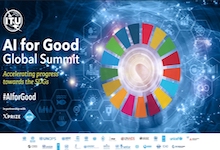AI + satellites
17 May 2018 02:00h
Event report
This breakout session addressed the potential of satellite imagery, combined with artificial intelligence (AI) and machine learning, to help meet the sustainable development goals (SDGs). The session was opened by the moderator, Mr Stuart Russell (Professor of Electrical engineering and Computer Sciences, US Berkeley), who explained that an enormous amount of satellite data is being produced every day. This wealth of data could provide a snapshot of the entire world, at once, in real-time. AI systems are needed to be able to effectively map all this data, as it will go beyond the capacity of human satellite interpreters.
Next, Mr Einar Bjørgo, (Manager of the UN Operational Satellite Applications Programme) mentioned that the fusion of technologies could help accelerate the impact of earth observation, especially if there is open access to geospatial images. This would allow the distribution of the right data to the right people when they need it, particularly if we would be able to directly ‘stream’ such images. Satellite imagery has particular advantages for monitoring the SDGs, as it provides global-scale data-sets, ‘covering everything, even the smallest islands’. At the same time, Bjørgo indicated that the use of these technologies still requires extensive capacity development and training.
Mr Mark Doherty (Head of Earth Observation Exploitation Development Division, European Space Agency) identified the ‘tsunami of satellite data’ that is generated, especially with the rise of satellites from the private sector. Doherty explained that this data in particular could contribute to SDGs 2 (zero hunger), 11 (sustainable cities), 13 (climate action), 14 (life below water), and 15 (life on land). With investments in public infrastructure, global monitoring, and a direct link to government policy, the EU is addressing a lot of obstacles related to the use of satellite data for the public good. Doherty echoed Bjørgo’s emphasis on the importance of free and open access, and added that there are still a number of challenges to overcome related to universal standardisation, the ease of using satellite data, and the validation of this data. AI can help detect patterns and models that cannot be captured by humans, helping to identify the signals that provide predictive power and ‘deliver on full societal benefits’.
Andrew Zolli (Vice President of Global Impact Initiatives, Planet Labs Inc.) explained that his organisation daily creates images that capture the whole world, making global change visible with a large number of small satellites. This allows for the exploration of patterns and changes in systems. For example, it could help track the growth of refugee camps or the number of solar panels in a country. As there is more information generated than we can pay attention to, AI can assist in obtaining insights from continuously refreshed imagery, providing real-time analytics of social and ecological systems. To unleash this potential, the system as a whole needs to overcome its current fragmentation, requiring more coordination for ‘all of the groundtruth and satellite data to work together for the collective common good’.
Mr James Crawford (CEO and Founder of Orbital Insight) explained that AI can address the current bottlenecks that appear due to a lack of human capacity to interpret satellite imagery – it is simply impossible to look at all images every day. Crawford listed a number of examples of how this could be put into practice. For example, AI could detect patterns in deforestation, land use, and flooding. Ultimately, these technologies could be used to understand all socioeconomic and ecological processes.
Mr David Jensen (Head of Environmental Cooperation for Peacebuilding and Co-Director of MapX, UN Environment Programme) raised some of the main governance questions related to the interplay between AI and satellite data for the SDGs. Jensen pointed out the enormous complexity of measuring 232 indicators for 193 countries is not unlike ‘solving a Rubik’s cube with 193 sides’. AI would be a perfect tool to mitigate the balances and trade-offs inherent to the SDGs, yet it is hindered by a lack of harmonisation among data sources. In addition, there is a capacity, knowledge, and information gap between industry, on the one hand, and governments and civil society, on the other. This has created imbalances that are at risk of being exacerbated. In conclusion, Jensen coined the question, of ‘how to create incentives and standards to keep satellite data and related AI algorithms in the public domain’.
Related topics
Related event

